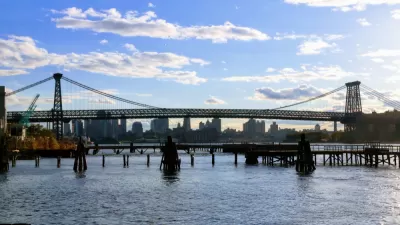In this op-ed special to The Sacramento Bee, Michael Andersen of PeopleForBikes and Melissa Merson of America Walks make a convincing argument for protected bike lanes to improve both bike and pedestrian safety by getting cyclists off the sidewalk.

It's illegal in many (if not most) places to bike on sidewalks, and it's dangerous, not only for pedestrians, but for cyclists themselves. Yet cyclists continue to do it for a very simple reason: it's perceived to be safer than the alternative—biking in the street with traffic.
"People bike on sidewalks for two main reasons: because they’re looking for a space that’s physically separated from cars and trucks, or they’re traveling against traffic on a one-way street," write Anderson and Merson.
Nobody prefers to ride a bicycle on a sidewalk next to people on foot, who are inherently unpredictable: they may suddenly stop to tie a shoelace or turn to look in a storefront window.
The best way to get bikes off sidewalks is to construct protected bike lanes, they argue. "Protected bike lanes sharply reduce sidewalk biking, resulting in fewer clashes, recent city studies shows," they write.
Well-designed, protected bike lanes, which use posts, curbs or parked cars to divide bike and auto traffic, create a safer solution to both of these needs. In project after project, adding a protected bike lane to a street has sharply cut sidewalk biking even as it greatly increased bike traffic.
And they have evidence from D.C., Manhattan and Brooklyn to prove their point that protected bike lanes protect pedestrians from cyclists as much as they protect cyclists from motor vehicles. Anderson and Merson wrote this piece to add Sacramento to the below list.
- On L Street in Washington, D.C., bike traffic jumped 41 percent with a new protected lane, and the number of bikes on sidewalks fell 27 percent.
- With a protected lane project on Columbus Avenue in New York City, bike traffic jumped 56 percent; the number on sidewalks fell 46 percent.
- On Brooklyn’s Prospect Park West, biking soared 190 percent; sidewalk riding plummeted 81 percent.
Diverting just $1 million of that to create 35 miles of protected bike lanes each year (that’s at $30,000 per mile) would increase the long-term capacity of Sacramento’s street system by making biking a safe and comfortable alternative to the car – while also making walking on sidewalks safer and more pleasant.
FULL STORY: A solution for bikes and pedestrians

Planetizen Federal Action Tracker
A weekly monitor of how Trump’s orders and actions are impacting planners and planning in America.

Maui's Vacation Rental Debate Turns Ugly
Verbal attacks, misinformation campaigns and fistfights plague a high-stakes debate to convert thousands of vacation rentals into long-term housing.

San Francisco Suspends Traffic Calming Amidst Record Deaths
Citing “a challenging fiscal landscape,” the city will cease the program on the heels of 42 traffic deaths, including 24 pedestrians.

Amtrak Rolls Out New Orleans to Alabama “Mardi Gras” Train
The new service will operate morning and evening departures between Mobile and New Orleans.

The Subversive Car-Free Guide to Trump's Great American Road Trip
Car-free ways to access Chicagoland’s best tourist attractions.

San Antonio and Austin are Fusing Into one Massive Megaregion
The region spanning the two central Texas cities is growing fast, posing challenges for local infrastructure and water supplies.
Urban Design for Planners 1: Software Tools
This six-course series explores essential urban design concepts using open source software and equips planners with the tools they need to participate fully in the urban design process.
Planning for Universal Design
Learn the tools for implementing Universal Design in planning regulations.
Heyer Gruel & Associates PA
JM Goldson LLC
Custer County Colorado
City of Camden Redevelopment Agency
City of Astoria
Transportation Research & Education Center (TREC) at Portland State University
Jefferson Parish Government
Camden Redevelopment Agency
City of Claremont





























